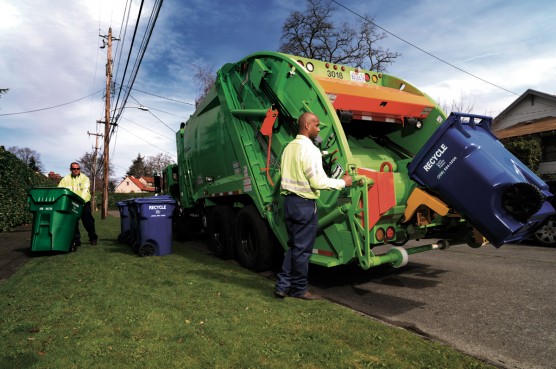
Photo: Tagging-trash
Tagging trash: what cities can learn for better waste management
19 September 2012
by Richard Forster
In 2009, researchers from the Massachusetts Institute of Technology (MIT) SENSEable City Laboratory embarked on a project called Trash Track, which used electronic tags to track different types of waste on their journey through the disposal systems of New York and Seattle. Nick Michell looks into the results of the two-year programme and the lessons for urban waste management
In today’s society many people are concerned about the ‘supply chain’ of the products they buy. People care whether their fruit and vegetables are organic or their eggs are free-range, and whether they are produced domestically or imported, but knowledge of the ‘removal chain’, in other words, where all their waste goes once it is disposed of, is far less advanced. If we knew exactly where our waste goes, how far it travels, and how much energy it takes to make it disappear, would it make us think twice before buying bottled water or disposable razors?
Waste management is becoming a tougher challenge for cities because as the World Bank revealed in its June report What A Waste: A Global Review of Solid Waste Management, the amount of municipal waste being generated per person is outstripping the rate of urbanisation. In 2002, 2.9 billion urban residents generated 0.64 kg of waste per person per day. By 2012, this had risen to 3 billion residents generating 1.2kg per person a day, which will rise in 2025, to 4.3 billion urban residents producing 1.42 kg per person per day.
The annual global cost of this solid waste management is projected to rise from the current US$205 billion to US$375 billion by 2025, with the cost increasing most severely for those cities in low-income countries. “Improving solid waste management, especially in the rapidly growing cities of low-income countries, is becoming a more and more urgent issue,” says Rachel Kyte, Vice President, Sustainable Development at the World Bank.
To highlight the importance of better waste management and the lack of detailed data on trash disposal, a team of MIT researchers initiated the US project Trash Track in 2009, funded through collaboration with Waste Management Inc., Qualcomm Inc., Sprint and the New York Architectural League. The research team attached special electronic sensors to 3,000 different types of trash and tracked their geographical path through the disposal systems. The project monitored the patterns and costs of urban disposal, to create awareness of the impact of trash on the environment and to reveal the last journey of everyday objects.

“Trash is one of today’s most pressing issues, both directly and as a reflection of our attitudes and behaviour,” says Carlo Ratti, Director of the SENSEable City Lab. “Our project aimed to reveal the disposal process of our everyday objects, as well as to highlight potential inefficiencies in today’s recycling and sanitation systems. The project could be considered the urban equivalent of nuclear medicine, where a tracer is injected and followed through the human body to reveal how a system functions.”
MIT partnered with the Seattle Public Utilities Office to map out the region’s solid waste collection and processing system prior to the Trash Track implementation and to recruit volunteers to participate in tagging their trash. Households were given a wish list of items MIT wanted to track, including mobile phones, fluorescent light bulbs, and other household hazardous waste that is difficult to regulate, with the electronic sensors shielded by an insulating foam to protect them from being crushed.
“Compared to many other US cities, Seattle’s solid waste system is somewhat complex,” says Brett Stav, Senior Planning & Development Specialist for the Seattle Public Utilities Office. “We separately collect garbage, recycling and organics. We offer drop-off collection services for various household hazardous wastes (HHW). Our challenge is to make the system as efficient and cost-effective as possible, while also making it accessible and convenient to our customers. I found the project’s aim and premise to be intriguing; we provide solid waste services to 600,000 people and, if properly implemented, Trash Track could provide an ‘audit’ on the efficiency and effectiveness of our collection and delivery systems.”
Garbage collection contractors in Seattle make 150,000 collections of single-family garbage every week alone and this material is processed and shipped six days a week to a landfill in Oregon, 480 kilometres away. Recyclables are processed in a facility in town and shipped all over the world, with some of these materials recycled into new products and back on store shelves within 60 days. Organic waste is processed at a facility 32 kilometres north of Seattle and then delivered to local store shelves as garden compost within 90 days. However, household hazardous waste, as Trash Track discovered, has a more complex deconstruction chain model.
Results
After the implementation of Trash Track in 2009, the electronic tags’ trajectories were monitored in real-time on a central server at MIT, over the following two years. Of the 3,000 individual pieces of garbage followed by the team 95 percent of the trash stream stayed within city limits when it was disposed of at its final destination. For instance, an aluminium can in Seattle would travel for around two days and 4 kilometres before reaching its end destination.
However, the results also showed how far some of the waste travelled, effectively spreading across the entire country. Electronic and household hazardous waste, for example, which was sent to specialised recycling and reuse facilities in other states, travelled on average more than 1,500 kilometres. One printer cartridge reportedly travelled an astonishing 6,152 kilometres to be recycled, highlighting that, in some cases, the carbon emissions produced in transporting waste to a recycling facility negates the expected environmental benefit of recycling.
“We learned that we underestimate the role of transport, especially for electronic waste,” says Dietmar Offenhuber, researcher at the SENSEable City Lab. “The benefit of recycling, which is always taken for granted, is in fact a function of many different factors, some of them positive and some negative. We found that transport distances are generally treated too optimistically, both in terms of distance and emissions. If we want a better view on recycling, we have to look closer at transport, not just the miles, but also handling, mode changes etc.”
It is clear from the results that it is not only the residents of cities that need to understand and learn about the ‘removal chain’ of waste, but also the local authorities that deal with collection and delivery.
“For national organisations like the EPA [Environmental Protection Agency] or various state environmental agencies, as well as companies in the ‘removal chain’ industry, it’s incredibly important to see how much impact removal chain processes have on costs and on the environment,” says Brett Stav. “On a national level, Trash Track highlighted how much the HHW market has room for improvement in its removal chain efficiency. In a nutshell, Trash Track has begged the question: ‘How far can a CFL light-bulb or an old cell phone travel to be disposed of in an environmentally and cost-effective manner?”
The video cannot be shown at the moment. Please try again later.
Behavioural change
Residential recycling and composting programmes are reliant upon their citizens to make them a success and therefore educating the public is essential. People need to have a reason for the amount of time they spend sorting, rinsing and storing their trash, and would consequently find it comforting to know that their waste will actually end up where they wanted it to go.
“People tend to not want to think about what happens to stuff they throw away, and this study is a graphic reminder that trash just doesn’t disappear once it leaves the curb,” says Stav. “The Seattle Public Utilities Office (SPU) commits a lot of resources educating its customers that recycling/composting is cost-effective, good for the environment, and energy-efficient. Since Trash Track, SPU has developed an online database where customers can look up exact items, for example, a metal coat hanger, to find out how to properly dispose of it.”
The MIT team conducted surveys with participants who viewed the results of the Trash Track project, and found that it had a significant impact on their understanding of trash systems, but not necessarily on their behaviour though Lynn Brown, Vice President of Corporate Communications for Waste Management Inc., believes that informing citizens of the ‘removal chain’ process, at least gives them the choice of what they buy and throw away.
“Say I am holding a plastic bottle, although I hope I wouldn’t be drinking from a plastic bottle, I have the choice of how I dispose of it,” says Brown. “I think if we are provided with the information of the disposal paths of our waste, in terms of where it goes, how far and the energy consumed, then we are at least in a more informed position to decide what we buy and throw away. We at Waste Management want to teach people about how we recover the resource that is in waste and extract the value.”
The future
Following on from the initiative, the SENSEable City Lab team has turned its attention to waste management in the developing world with a project called Forage Tracking, working with a cooperative of informal recyclers in São Paulo. In this city, the goal was not to use tracking as a way of passively observing trash but rather as an active tool for management.
The Forage Tracking project is mapping the tacit knowledge and spatial organisation of informal recyclers. It is using location-detecting hardware and software to investigate how catadores, informal recyclers in Brazilian cities, find and collect material in the city, while also developing participatory platforms that will help them to organise their activities and connect the cooperative to citizens.
“Their waste management issues are complicated, but they also benefit from a closer relationship between waste collectors and citizens,” says David Lee, researcher for SENSEable City Lab. “There’s an opportunity to develop waste systems that are more transparent and democratic than what we usually see in the developed world.”
Most recycling cooperatives gather material by roaming the city in trucks or pushing handcarts. They collect recyclable items by the hundreds of kilograms, and the ways in which they find and retrieve these are not well understood. Using GPS and mobile phones, the SENSEable City Lab can help them document this tacit knowledge, which can then be applied to optimising routes, forming new partnerships, and demonstrating key capital needs.
Trash Track attempted to encourage people to make more sustainable decisions about what and how much they consume. The project represented a bottom-up approach to managing resources, promoting more informed decision-making in the public through the use of pervasive technologies and information. However, the concept of 100 percent recycling in the future is not something that Dietmar Offenhuber believes is necessary.
“I do not think recycling is always something positive and desirable under all circumstances,” says Offenhuber. “Maybe everything can be recycled somehow, but this does not necessarily mean that it will always be good for the environment. Reducing waste is the overall goal, for example by restructuring production and consumption patterns and through reuse.”








